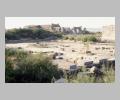|
| Context: |
Miletus |
| Type: |
Sanctuary |
| Summary: |
The sanctuary of Apollo Delphinios is a rectangular temenos enclosure bordered by two-aisled stoas at the north, east and south. The sanctuary is situated to the north-east of the North Market of Miletus, close to the Lion Harbor. |
| Date: |
ca. 340 BC - ca. 320 BC |
| Dimensions: |
Exterior dimensions of sanctuary ca. 61.3 m. x 51.6 m. Depth of porticoes on north, east and south 10.05 m. Outer colonnade: lower diameter of columns 0.50 m., intercolumniation 2.98 m. (?). Inner colonnade: lower column diameter 0.57 m., intercolumniation 5.96 m. |
| Region: |
Ionia |
| Period: |
Hellenistic |
Architectural Order:
Doric and Corinthian. Lower column drums of the inner colonnades still in situ have no bases, and thus the order is restored as Doric. In the Roman period, porticoes with Corinthian columns and a propylon with composite capitals were constructed.
Plan:
In plan, the sanctuary consists of an open, rectangular temenos area with two-aisled stoas at the north, east and south. The north and south porticoes were bisected by a cross-wall. At the west, a wall with two doorways formed a boundary for the temenos; the wall was later replaced by another portico. Within the temenos are located semi-circular exedrae or votive benches, a round temple or monopteros dating to the Roman period, and a rectangular altar.
Date Description:
The evidence for the date of the Hellenistic stoas comes from a building inscription on the rear wall concerning activity in the sanctuary. The text is as follows: *E*D*O*C*E*T*H*I*B*O*U*L*H*I*K*A*I*T*W*I*D*H*M*W*I*H*G*H*S*I*A*N*A*C*E*I*P*E*P*R*O*S*T*H*N*C*U*L*W*S*I*N*T*H*S*S*T*O*I*H*S*T*H*S*K*A*I*N*H*S*T*H*S*E*N*T*W*I*I*E*R*W*I*T*O*U*A*P*O*L*L*W*N*O*S*M*H*E*C*E*I*N*A*I*P*I*N*A*K*A*A*N*A*Q*E*I*N*A*I*M*H*D*E*A*L*L*O*M*H*D*E*N*O*P*W*S*M*H*B*L*A*P*T*H*T*A*I*H*C*U*L*W*S*I*S*M*H*D*E*P*R*O*S*T*O*U*S*K*I*O*N*A*S[*H]*N*D*E*T*I*S*B*O*U*L*H*T*A*I*A*N*A*T*I*Q*E*N*A*I*T*I*E*I*S*T*H*N*S*T*O*I*H*N*T*H[.]*K*A*I*N*H*N*A*N*A*T*I*Q*E*T*W*P*R*O*S*T*O*U*S*T*O*I*X*O*U*S*T*O*U*S*A*L*E*I*Y*O*M*E*N*O*U*S*U*P*O*K*A*T*W*T*O*U*A*N*T*I*D*O*K*I*O*U*T*O*U*L*I*Q*I*N*O*U*H*N*D*E*T*I*S*A*N*A*Q*H*I*P*A*R*A*T*O*Y*H*F*I*S*M*A*O*F*E*I*L*E*T*W*D*E*K*A*S*T*A*T*H*R*A*S*I*E*R*O*U*S*T*O*U*A*P*O*L*L*W*N*O*S. "The Boule and the demos decreed: Hegesianax spoke that (no-one?) should come out to dedicate tablets against the framework of the new stoa in the sanctuary of Apollo,....... and nor should the framework be damaged..... and if anyone wishes to dedicate anything in the new stoa, let him dedicate it against the ..... walls beneath the stone supporting beam; and if anyone dedicates not in accordance with the decree, let him be liable for ten staters to the priests of Apollo." The inscription is dated on the basis of its letter forms to ca. 340-320 B.C.
The construction technique and materials of the foundations indicate that a pre-Hellenistic structure stood on the site of the sanctuary.
History:
Since the cult of Apollo Delphinios is Cretan in origin, it is assumed that a sanctuary existed at Miletus for the worship of Apollo Delphinios from the period of the earliest settlers. There is literary evidence for a Delphinion at Miletus in the sixth century B.C., Diogenes Laertius 1.29, although the earliest remains at the site of the present Delphinion date to the fifth century B.C., and the location and form of the archaic sanctuary are uncertain. The earliest preserved remains at the Delphinion are the rectangular altar with volute acroteria, and a number of marble round altars; these predate the Persian destruction of 494 B.C. It is thought that the round altars were collected from various locations and brought to the Delphinion at this time. In the fifth century B.C., when Miletus was rebuilt, the Delphinion took the form of a small rectangular enclosure of ca. 30 x 45 m., which was bordered by stoas at the north and south. Fragments of archaic building materials were reused. In the late fourth century B.C., the sanctuary was renovated and enlarged, expanding to the east and now measuring ca. 61 x 51 m. New two-aisled stoas with inner and outer colonnades of the Doric order were built at the north, east and south sides, while the west side was closed off with a wall. In the late Hellenistic period, the enclosure was made completely peristylar with the addition of a one-aisled stoa at the west. In the mid-second century A.D., a circular shrine or monopteros was constructed in the temenos, and the porticoes were altered to single-aisled colonnades with Corinthian capitals. A propylon was also erected in the middle of the west side.
Other Notes:
The annual Spring procession which went from Miletus to the Temple of Apollo at Didyma began at the Delphinion. The architectural form of the sanctuary, an open court, was appropriate for a gathering place and for the performance of sacrifices.
The numerous inscriptions (dating from the archaic to the late Roman periods) preserved on the walls of the Delphinion indicate that the sanctuary also functioned as the city archive. For the inscriptions, see Kawerau and Rehm 1914, 162-406. One inscription Kawerau and Rehm 1914, no. 32 refers to the construction of a "new" portico; the inscription is dated to ca. 340-320 B.C. and thus not only provides a date for the construction of the Hellenistic porticoes but also indicates that an earlier portico (or porticoes) stood on the site.
Other Bibliography:
Kawerau and Rehm 1914; von Gerkan 1950, 35-39; Kleiner 1968, 33-35, figs. 17-18; Coulton 1977, 64, 101, 169, 171, 258, fig. 86.3.
